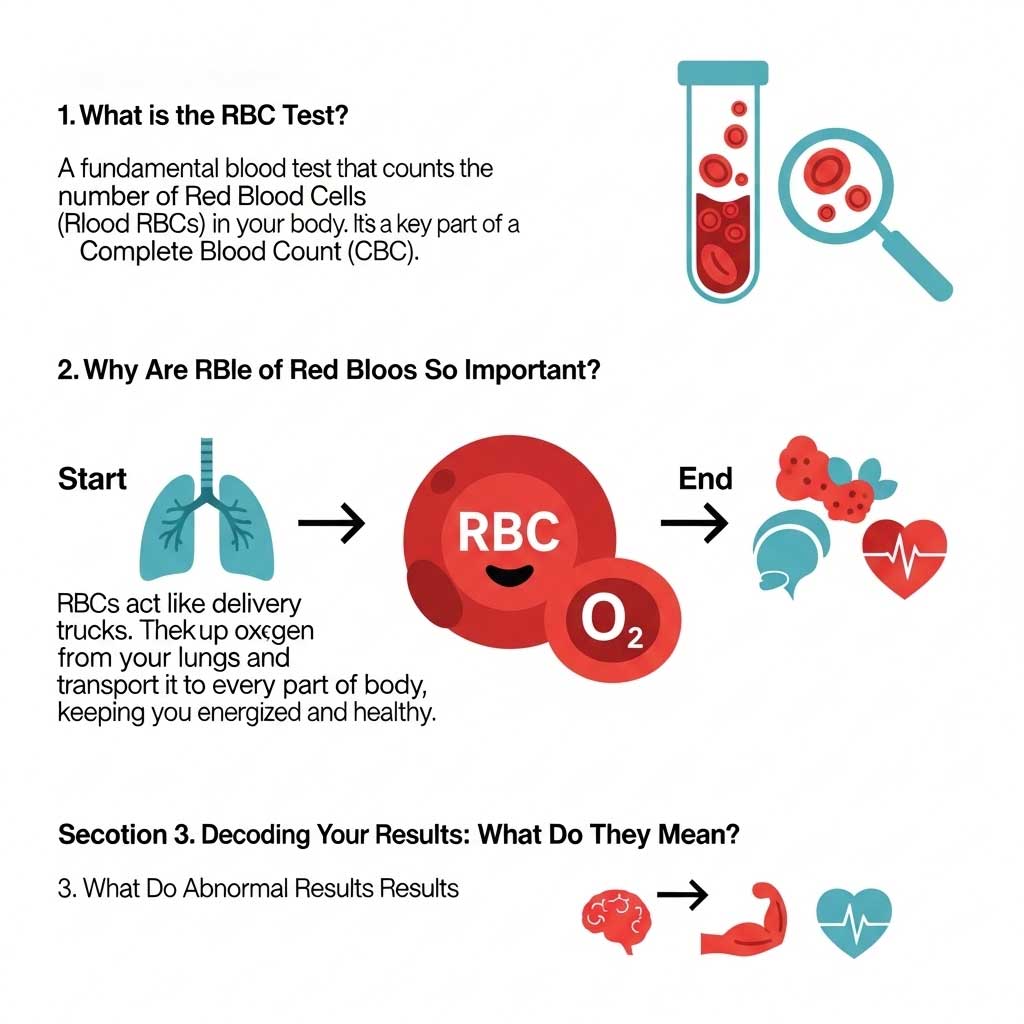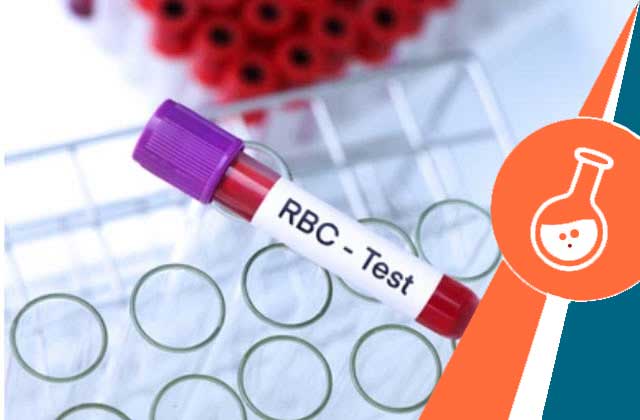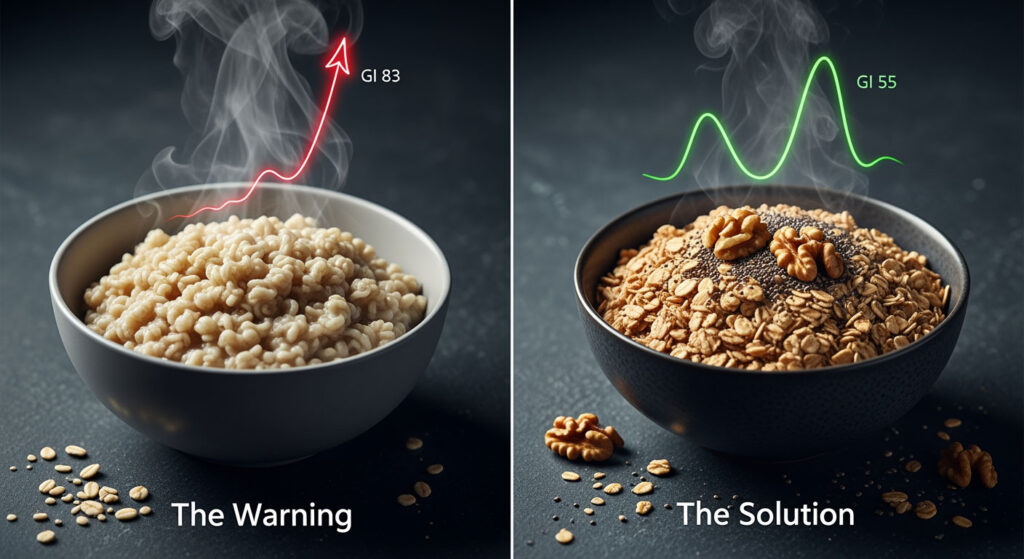
What is RBC Blood Test?
A red blood cell (RBC) count measures the number of red blood cells in your bloodstream. These cells carry haemoglobin, a protein that transports oxygen throughout the body.1 Also, Red blood cells (RBCs), or erythrocytes, play a crucial role in transporting oxygen from your lungs to the rest of your body. Typically included as part of a complete blood count (CBC), the RBC count can also be conducted independently to focus specifically on the erythrocytes.
RBC Blood Test plays a key role in the early detection of a wide array of medical conditions, from simple infections to complex disorders like anaemia and even tumours.
Understanding the levels of red blood cells can help diagnose health issues that affect oxygen delivery to tissues, enabling effective management of potential illnesses, often before symptoms manifest.
About RBC Count Test
Learn everything about the RBC Count Blood Test, before you book lab test online. Understand the why, how, and what of this test.
Why Do Doctors Recommend RBC Blood Tests?
An RBC Blood test is recommended in the following scenarios:
- As part of a Routine health checkup
- When you’re experiencing symptoms of less than normal RBC counts like dizziness, tiredness, shortness of breath, irregular heartbeat, etc.
- When you’re experiencing symptoms of higher than normal range RBC like fever, chills
- To monitor the effect of irradiation or chemotherapy2 on total RBC counts
What Does Red Blood Count Indicate About My Health?
Any deviation from the normal RBC counts may yield a wealth of information to your doctor. Raised counts in an RBC blood test are commonly seen in an infection, whereas low red blood cell counts are most commonly seen in anemias. It may also reflect your hydration status as well.
How To Prepare For the RBC Test?
The steps below help you ensure that your RBC test provides the most accurate information about your health.
- Medication guidelines: Tell your healthcare provider about all the drugs, supplements or herbal remedies you are taking, as some substances may affect test results. Follow any specific instructions regarding drug adjustment before testing.
- Contact to doctor: Share your entire medical history with existing conditions or symptoms to help explain test results.
What Happens During RBC Testing?
An RBC Test only takes a few minutes.
- As per the scheduled time of the blood test, a Lab Technician who usually takes blood samples will arrive.
- A thin needle will be used to draw blood from your arm’s vein.
- The needle might cause a mild pinch and some discomfort.
- The lab technician then fills a collection tube with blood and then removes the needle from the skin.
- They place a small bandage on the arm
Please note: There might be slight pain or bruising at the spot of insertion, but most of the symptoms go away quickly.
Finding RBC Count Test
Should you book blood test online to check your health condition or go to the nearest clinic and get it done by a medical professional? Let’s Find Out
Can I Take an RBC Test At Home?
Yes, the RBC Test can be taken at home. HealthcareOnTime’s at-home lab testing service, in association with thyrocare, provides a convenient and efficient way to get blood testing done from the comfort of your own home without the need for a doctor’s visit or a trip to a lab. It’s important to note that it’s always a good idea to consult with an expert healthcare provider about any queries you may have about your test results.
How Much Does RBC Test Cost?
The RBC test price varies significantly depending on many factors:
- Location: The RBC test prices in India may vary depending on the city or the region in which the test is conducted. For example, in Bangalore or Mumbai, it might be expensive as compared to small towns.
- Type of facility centres: The RBC test charge also varies between private hospitals, government hospitals, and diagnostic centres. Cost is lower in government hospitals as compared to private ones.
- Healthcare centres: Diagnostic centres, laboratories and hospitals may have different RBC test prices. It depends upon the benefits and reputation of the healthcare centre.
- Insurance Coverage: Individuals with health insurance can cover partial or all costs depending on their policy coverage and network providers.
- Additional services: Additional services such as home sample collection, express test results, or additional charges for special management may be paid, which contributes to the overall RBC test price.
Generally, the RBC test cost in India ranges from Rs. 100 to Rs. 1500. By opting for HealthcareOnTime lab test at-home facilities, you can access the RBC test at the cost of INR 150.
Test Result Interpretation
You received your RBC count test results but still need help determining if they fall under the RBC normal range. Read this section to know if your results range between the normal RBC counts.
What Do my RBC Count Test Results Mean?
RBC count test results are generally given in the units of million cells per microlitre of blood. Any number lying within the standard range, as described in the section below, is considered to be normal.
- A high red blood cell count (erythrocytosis) means your blood has more red blood cells than normal, making the blood thicker and potentially increasing the risk for blood clots. This condition might signal various health issues, including dehydration, heart disease, polycythemia vera, lung scarring from smoking, lung disease, and kidney cancer. 3
- Conversely, a low red blood cell count can suggest conditions such as internal bleeding, kidney disease, or malnutrition. It could also indicate deficiencies in vitamins such as B6, B12, or folate4. Lower than normal RBC counts may impair the body’s ability to carry sufficient oxygen to its tissues, potentially leading to fatigue and other symptoms associated with anaemia.
In both cases, further testing by a healthcare provider is necessary to determine the specific cause of the abnormal RBC count and to guide appropriate treatment strategies.
What is RBC Count Test Normal Range?
The RBC normal range is subject to changes depending on your gender, age and nutritional status. Total RBC counts are generally higher in males than in females and higher in newborns than in adults. The widely accepted total RBC count normal range for men, women, infants, and children is given below:
Age | RBC NORMAL RANGE(million cells/µL) |
Adult, assigned female at birth | 4.2 – 5.4 |
Adult, assigned male at birth | 4.7 – 6.1 |
Child, 1 – 18 years | 4.0 – 5.5 |
Infant, 6 – 12 months | 3.5 – 5.2 |
Infant, 2 – 6 months | 3.5 – 5.5 |
Infant, 2 – 8 weeks | 4.0 – 6.0 |
What is Considered a High Red Blood Cell Count?
While the normal RBC count varies based on factors like age and gender, a count exceeding specific thresholds is classified as high.
An elevated red blood cell count typically exceeds 6.1 million for males, 5.4 million for females, and 5.5 million for children. Your healthcare provider will conduct further tests to identify the underlying cause of this condition and outline appropriate steps for your care. 5
A high total RBC count can indicate various health conditions and warrants further investigation. Upon detecting elevated levels, healthcare providers typically recommend additional tests to pinpoint the underlying cause and determine the appropriate course of action for treatment.
What is Considered a Low Red Blood Cell Count?
Anything less than 4.7 million cells per microlitre of blood in an RBC test is considered to be a low total RBC count in adult males, while for women, it is considered low if it is less than 4.2. 6
What Medical Conditions Can Cause Low Red Blood Cell Counts?
Low blood cell counts in an RBC test can be seen in the following health conditions:
- Low levels of iron, vitamin B12, or folic acid
- Cancer or cancer treatment (such as chemotherapy or radiation therapy)
- Some chronic diseases, such as kidney disease
- Deficiency of erythropoietin, a kidney hormone that promotes RBC growth
- Malnutrition that affects bone marrow’s ability to produce RBCs, leading to malformed RBCs or a higher rate of RBC death
- Sickle cell disease
- Blood loss due to excessive bleeding
What Medical Conditions Can Cause High Red Blood Cell Counts?
Increased red blood cell counts in an RBC blood test can be seen in the following conditions:
- Dehydration
- Chronic obstructive pulmonary disease (COPD) and other long-standing cardiac conditions
- Living at high altitudes
- Polycythemia vera, a bone marrow disease
- Drugs like anabolic steroids
More Related Tests
Why To Book with HealthCareOnTime

17 Crores+ Samples Processed

World Class Technology Labs

25+ Years of Trust & Experience

Free Home Collection
FAQs Around RBC Blood Test (Total RBC Count)
How much does RBC Blood Test (Total RBC Count) cost?
The RBC Blood Test (Total RBC Count) cost is Rs.350, although it is now available for Rs.150 because of the offer.












